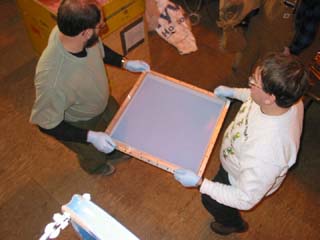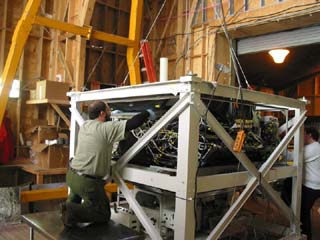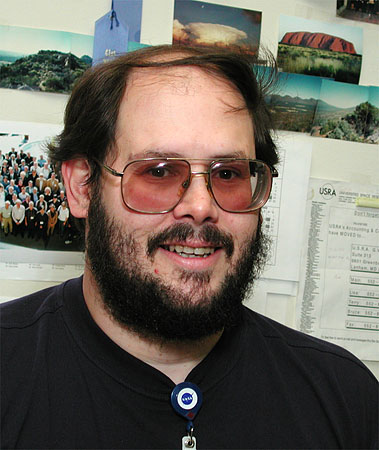TIGER in Antarctica
November 15, 2001
Installing Aerogel
The big job on the 15th is installing the aerogel detectors into the instrument. Aerogel is a extremely light weight glass that is made by mixing glass and a type of gelatin, and then baking out the gelatin. This leaves only a spread out matrix of glass with lots of air pockets. It looks and feels like solid smoke. Aerogel is very fragile and sensitive to moisture and chemical fumes, so we have been trickling pure, dry nitrogen gas through the box that the aerogel pieces were stored in, but now they're ready to go into the instrument.
 The aerogel pieces are about 50 cm square and 3 cm thick. These pieces are almost irreplaceable because the Swedish factory, that was the only one in the world that could make pieces this big, blew up. They are caulked into square aluminum picture frames. We need four (a 2 x 2 square) to cover the whole active area of the instrument.
The aerogel pieces are about 50 cm square and 3 cm thick. These pieces are almost irreplaceable because the Swedish factory, that was the only one in the world that could make pieces this big, blew up. They are caulked into square aluminum picture frames. We need four (a 2 x 2 square) to cover the whole active area of the instrument.
Photo on right: Jason and Eric moving aerogel
As a high energy cosmic ray passes through this aerogel, it emits a very small amount of light called Cherenkov light. Cherenkov light occurs when a electrically charged particle is moving faster than the local speed of light. Light moves at a constant speed in a vacuum, but it slows down when it passes through matter. The amount of light given off allows us to measure the speed of the cosmic ray.
 Inserting the blocks into TIGER is a difficult job because we don't want to do much disassembly of a working instrument. Some of the wires are very difficult to connect and disconnect. We start by unbolting the detectors above the aerogel Cherenkov counter. Then we carefull hoist them up in the air. A couple of inches up we can already see that some wires need to be disconnected. By moving slowly up, we can just disconnect the minimum number of wires and raise the top detectors about 8 inches up.
Inserting the blocks into TIGER is a difficult job because we don't want to do much disassembly of a working instrument. Some of the wires are very difficult to connect and disconnect. We start by unbolting the detectors above the aerogel Cherenkov counter. Then we carefull hoist them up in the air. A couple of inches up we can already see that some wires need to be disconnected. By moving slowly up, we can just disconnect the minimum number of wires and raise the top detectors about 8 inches up.
Photo on left: Eric sliding aerogel into TIGER
Then we carefully slide the pieces in one by one and bolt them down. Then we put a top over the four pieces and tape it all up so that no light leaks into the Cherenkov detector. When you are trying to measure very small amounts a light, you can't allow any background light (from the room lights here or from the Sun during flight) to contaminate your measurement.
Then we carefully lower the top of the instrument back down and reconnect all the wires and bolts. We also start running nitrogen gas through the detector that the aerogel is in to make sure that it stays as pure as possible. Everything looks good and an important milestone is getting flight ready is now complete.

Dr. Eric R. Christian
Eric's Featured Scientist Profile
This page was last modified on December 19,
2002
|